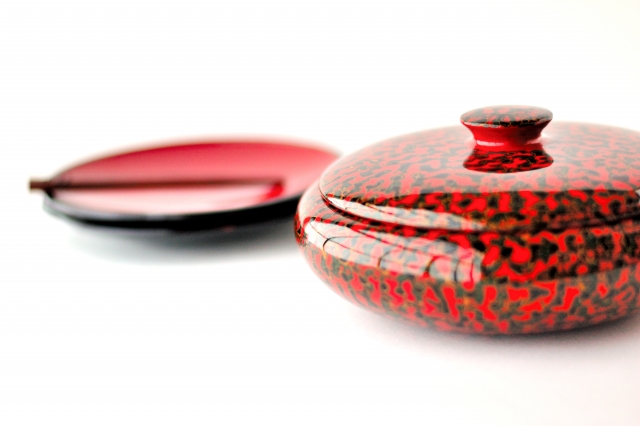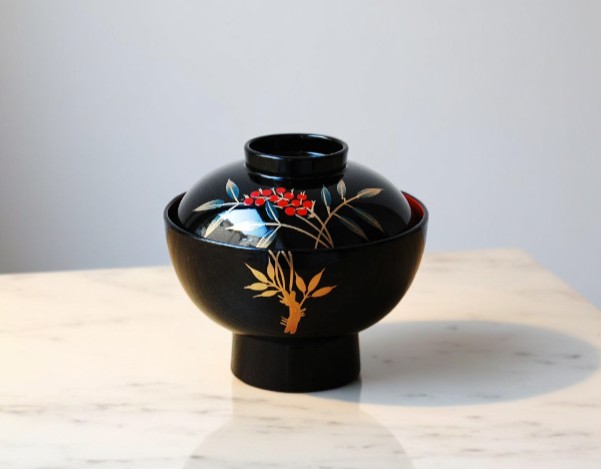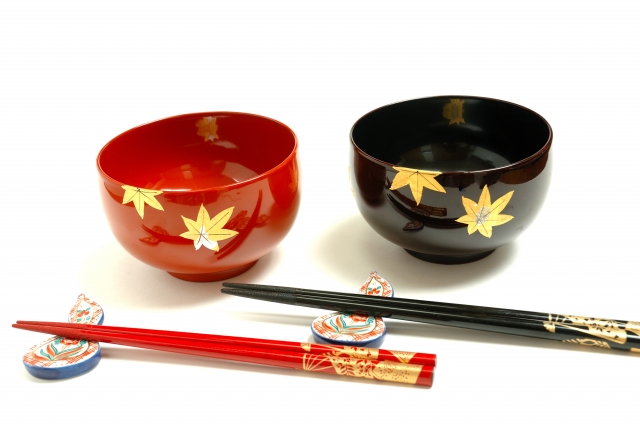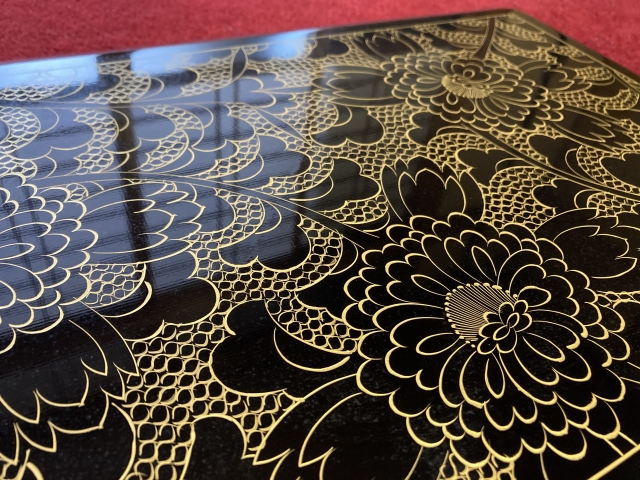A lustrous black, a deep, breathing vermilion.
The cool touch when held in hand, and the quiet glow that deepens with use—
Lacquerware is one of Japan’s most refined and profound traditional crafts, a mirror of the country’s unique aesthetic sensibility.
Today, its quiet beauty is beginning to resonate across the world.
Displayed in European museums, admired by renowned international designers, and embraced by those abroad who have begun to incorporate lacquer into their daily lives.
But this is no fleeting trend.
Rather, it spreads softly, like a whisper that lingers in the heart—reaching the senses in a way only lacquerware can.
This distinctly Japanese craft is not beautiful merely on the surface.
It holds within it the spirit of nurturing beauty over time, the heart to embrace and care for what is broken, and a quiet philosophy that lives in harmony with nature.
To touch lacquerware is not just to hold an object.
It is to brush against the passage of time in which people have lived alongside beauty.
Echoes of the Ancients: The Memory of Lacquer
The history of lacquer dates back to the Jomon period.
At the Sannai-Maruyama archaeological site in Aomori Prefecture—one of the largest prehistoric settlements in Japan, home to hundreds nearly 5,500 to 4,000 years ago—combs and vessels coated in red lacquer have been unearthed.
These were not simply tools of daily life, but beautiful, vividly colored ornaments. They speak to how even in ancient times, people recognized the radiance and allure of lacquer.
The sensitivity to decorate wooden tools with sap drawn from trees, to enhance them with beauty—this sensibility was already rooted in the Japanese spirit.
This discovery demonstrates that the use of lacquer in Japan began nearly 9,000 years ago.
It is not merely a technique—it is a cultural expression born of the delicate relationship between people and nature.
Through the Nara and Heian periods, lacquerware flourished in Buddhist and aristocratic settings. In the Muromachi and Edo eras, it entered daily life, enriched with decorative techniques like maki-e.
Lacquerware has adapted with the times, deeply rooted in both the practical lives and refined tastes of the Japanese.
It lives on not only as art of exquisite luxury but also as cherished tableware.
Even after a thousand years, the warmth of human hands and the stillness of spirit remain ever present.
The Philosophy Within the Layers
Creating lacquerware is not about efficiency or mass production.
Wood is shaped, primed, coated, dried, polished, and coated again—
The process can span dozens of steps, taking months to complete a single piece.
Every step is delicate; even humidity or weather can affect the final finish.
Artisans do not merely apply lacquer—they listen, layer by careful layer, as if in quiet conversation with the material.
There is no sound of machines or chatter in the workshop—
Only focused stillness and dialogue with the craft.
This spirit of layering echoes Bashō’s philosophy of fueki ryūkō—the unchanging and the ever-changing.
The technique remains constant, but it evolves with the times, adapting to the lives and sensibilities of each generation.
In lacquerware, timelessness and transformation live side by side.
The Silent Beauty That Speaks to the Hand
At first glance, lacquer may seem understated or reserved.
But beneath the surface lies the heart of Japanese aesthetics: harmony with nature, reverence for materials, and the deepening of beauty through use.
Within its countless layers lie the hours of careful work—the “time” of the artisan—and emotions quietly seep through the surface
It is this depth that quietly draws people in.
There is a mysterious presence in a piece of lacquerware.
Its vermilion and black surfaces gently reflect ambient light. It feels cool to the touch, and yet—somehow—warm.
Its appearance shifts with light and angle, evoking the sensation of stillness in motion.
The charm of lacquerware lies in its silent beauty.
Not in extravagance, but in the profoundness cultivated through time.
This is why lacquerware has been cherished as everyday tableware in Japan.
Not for showiness, but for the quiet dignity it holds within—that is the shape of beauty the Japanese have preserved.
An Object That Grows With Use
Lacquerware is not “complete” at the moment it is made.
With each use, its surface grows more lustrous, more profound.
This unique quality—the ability to age gracefully—is what makes lacquerware a craft that truly grows with time.
And even when it breaks or chips, it is not discarded.
Instead, a new beauty is born—through kintsugi, the art of repair using lacquer and gold or silver powder.
This reflects the deeply rooted Japanese sensibility of mono no aware—the gentle acceptance of impermanence.
Rather than hiding the flaw, it is embraced, honored as part of the object’s story.
Such is the emotional depth and spiritual grace of Japanese lacquer culture.
Landscapes of Lacquer Across Japan
Lacquer culture has taken root uniquely across the regions of Japan, shaped by nature, climate, and daily life.
Tsugaru-nuri (Aomori Prefecture)
Born of Aomori’s harsh winters, Tsugaru lacquerware features the togidashi kawari-nuri technique—layering dozens of coats, then polishing to reveal rich, marbled patterns.
It exudes the quiet of snow-covered stillness, and the slow awakening of life.

The distinctive patterns characteristic of Tsugaru-nuri have a depth reminiscent of marble.
Aizu-nuri (Fukushima Prefecture)
From the Aizu region, this style balances utility and elegance.
It flourished under feudal patronage in the Edo period, especially with the art of maki-e.
Its humble refinement embodies the folk spirit: true beauty lies in the everyday.

Aizu-nuri combines both practicality and beauty.
Yamanaka Shikki (Ishikawa Prefecture)
Centered in Yamanaka Onsen in Kaga, this lacquerware is famed for its woodturning.
Wood is delicately shaped on the lathe into refined curves—known as the work of “Yamanaka woodmasters.”
Yamanaka ware is not only visually stunning, but feels light in hand and gentle to the lips.
Modern interpretations are also thriving, blending tradition and innovation.

Yamanaka lacquerware features elegant, refined curves that highlight its graceful beauty.
Wajima-nuri (Ishikawa Prefecture)
Hailing from Wajima on the Noto Peninsula, this style boasts unmatched durability thanks to a unique base layer of diatomaceous earth.
Its elegance is heightened by chinkin and maki-e techniques.
It is in daily use, not on display, where Wajima’s strength and beauty truly shine.

Wajima-nuri is adorned with exquisite decorative techniques such as chinkin (gold inlay) and maki-e (gold and silver powder decoration).
Each region’s lacquerware reflects more than just style and technique—it reveals the spirit and life of its people.
Through a shared medium of lacquer, countless forms of Japanese beauty quietly endure.
What Is Quietly Passed On
Even as times change, the essence of lacquerware endures.
In an age overflowing with new materials and technologies, people still quietly reach for these timeless vessels—nurturing them, living with them.
They do not cry out to be noticed.
Instead, they remain quietly by our side, enduring with the passage of time.
Within a small vessel that fits in the palm of the hand lies the bounty of nature, the prayers of the artisan, and a silent yearning for beauty.
All gently layered, one by one.
Wajima-nuri — Nakajima Chuhei Lacquerware Shop
The Process Behind Crafting Beautiful Wajima-nuri Bowls






コメント